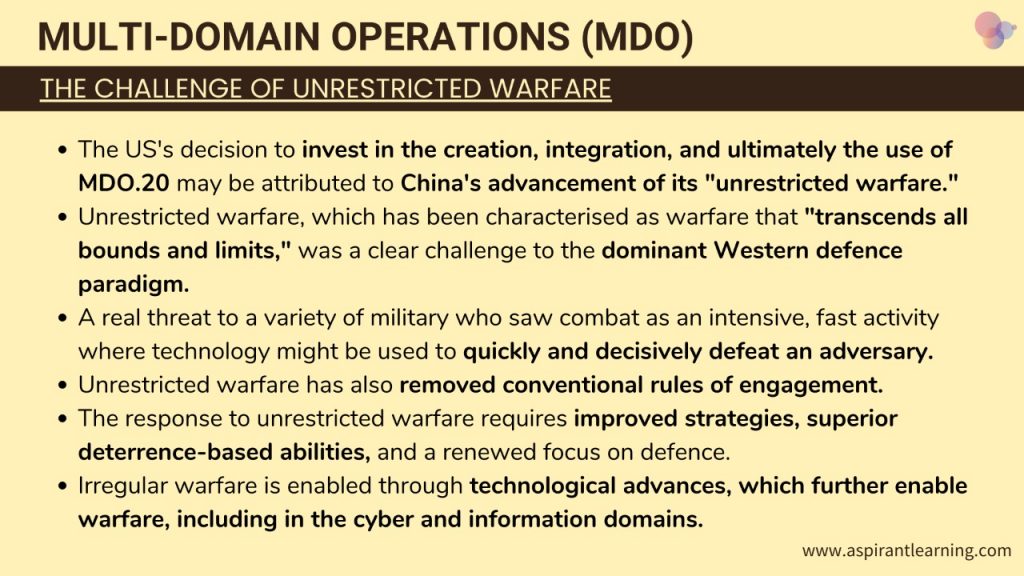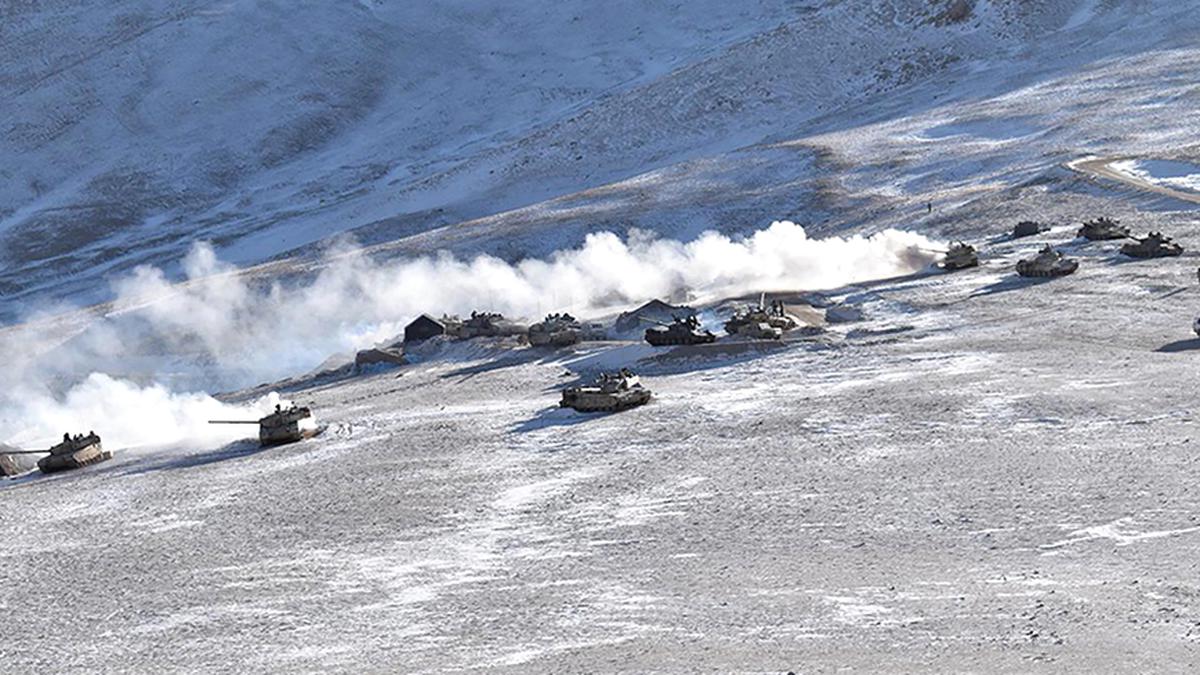News Highlight
Multi-Domain Operations: the India-China skirmish on the Arunachal Pradesh border has brought the Chinese threat to the front burner again.
Key Takeaway
- The threat had never decreased but faded in the public consciousness due to electioneering; bridge collapses, yatras, G-20, etc.
- The threat is at the other extreme of technical advancement in multi-domain operations (MDO).
Multi-Domain Operations (MDO)
- About
- The need for dynamic operations that integrate military assets across quickly evolving operational areas has given rise over the past few years.
- MDO combines new structures with cutting-edge technology to compensate for flaws and vulnerabilities in some areas while harnessing strengths in others.
- It’s crucial to remember that MDOs and joint operations have different conceptual foundations.
- They evolved in response to information warfare, the Anti-Access concept of warfare, and the electromagnetic spectrum debate (EMS).
- MDOs are becoming more essential as the space and cyberspace domains expand beyond their crucial roles as mere enablers of traditional domains.
- China and Pakistan have embraced hybrid and asymmetric warfare strategies, India’s primary danger sources.
- We must also include China’s Unrestricted Warfare, which combines several forms of warfare, including access-denial warfare, into a “Cocktail Style” strategy.
- Furthermore, confrontations involving several domains are expected to affect India.
- It necessitates its armed forces to confront its enemies with various threats.
What is a Domain?
- A domain is described as an “essential macro manoeuvre space whose access or control is vital to the freedom of action and superiority required by the mission.”
- The crucial elements in this situation are the ability to enter the domain, move around inside it, and seize control of it from a rival or an enemy.
- The idea of domains is unquestionably essential to MDO, which emphasises an integrated force capable of thwarting and neutralising an adversary in every area.
- As an operational concept, MDO will or should have a broader impact across the defence.
- Including procurement decisions, personnel selection, and training.
Multiple Domains and Anti-Area Access Denial
- Anti-Area Access Denial (A2AD) is a notion that has historically been connected to conflict between superpowers.
- One of the key drivers of the growth of MDO has been the need to combat the proliferation of A2AD systems being used to restrict access to certain theatres.
- By physically enclosing an area where military operations against violent non-state actors occur.
- Furthermore, it has also gained significance in the asymmetric arena.
- As more precise strike capabilities are developed, A2AD has been exploited as a global competition for military access.
- Along with significantly raising the risks of military engagement by extra-regional countries.
- It also strengthens the resolve and ambition of regional players.
- Additionally, MDO may be able to address the strategic-operational issues raised by an A2AD plan and capacity.
- According to research, A2AD capacity will be very helpful in blocking countries from operating in regions where they have historically had some freedom of movement.
- The clearest example of the use of China’s A2AD tactics to restrict the US’s freedom of navigation in some areas of the Western Pacific.

India’s Dependency on the South China Sea
- India has deemed the area of “secondary interest” and is eager to protect the freedom of navigation in the South China Sea.
- India’s hydrocarbon reserves rely on shipping lanes passing through the South China Sea.
- In addition, Indian company ONGC Videsh is currently involved in offshore hydrocarbon exploration off the coast of Vietnam.
- Geopolitical opponents may profit from any interruption to these operations.
- Additionally, according to strategic analysts, the Indian Navy will increasingly focus on the region, particularly in light of the marine nuclear deterrent.
- Chinese interests are threatened by their capacity to add naval, air, and surface assets to their highly effective A2AD network.
- The Central Military Commission has consolidated its centralised control.
- It established a new Rocket Force as part of the People’s Liberation Army’s restructuring efforts.
- Furthermore, shared commands have also been established.
The Impact of Multi-Domain Operations on India
- The word “national security” has been broadened to include all elements considered necessary for the country’s existence, development, and prosperity.
- With the diplomatic, military, and economic tools at its disposal, each nation employs a particular strategy to secure its survival and assert its power.
- It is committed to military effectiveness and leans on various capabilities in addition to doctrines to guarantee the accomplishment of national security goals.
- The defence institution is at its core and ensures these goals.
- Since its most recent conventional conflict, which took place in 1999, India’s national security goals have changed.
- Its development as a nuclear power has partly contributed to this, but other state actors’ threats.
- Such as those from Pakistan and China, have also been significant.
- India has historically prioritised going on the offensive and employing conventional forces.
- The nation is being forced by the evolving nature of war to engage in many conflicts to defend its national security.
- Therefore, it seems unlikely that India’s “cost-imposition measures” will deter its enemies from engaging in ongoing hybrid activities.
- Additionally, India’s geography has caused it to concentrate primarily on its land boundaries regarding security.
- We must remember that India has engaged in numerous land battles with its neighbours, greatly influencing its formative experiences.
- The air domain has consistently supported the land forces and served as an “independent strategic tool.”
Conclusion
- MDO is a changing warfighting strategy created to excel in a dynamic security environment.
- That is developing due to several technological advancements.
- MDO give commanders a variety of alternatives and capabilities for carrying out synchronised and sequential activities.
- They present an opponent with numerous problems that arise quickly from various operational domains.
- The goals also gain psychological advantage and supremacy in the operating environment.
- When accomplishing a country’s strategic goals and interests, MDO can also be a useful prism to prioritise its resources.
Pic Courtesy: The Hindu
Content Source: The Hindu



